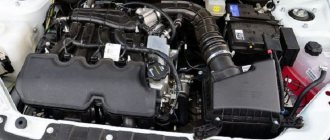Exterior
It is impossible to identify a leader here. Both cars are designed with speed and style, but the way they implement this concept is different.
It's no secret that the KIA Rio and Hyundai Solaris are essentially twins, especially in technical terms. But if Hyundai is aimed at sedate buyers over the age of 30, then Rio was created with an eye on the youth audience. This determined its design, made in the style of “flowing lines”. A tiger-nose radiator grille, long and narrow headlights, an air intake with a chrome baffle and fog lights are what attract buyers.
It's hard to resist such a car!
The profile of the car is slightly inclined forward, there are spectacular stampings along the side panels, the chrome of the window opening adds ambiance, the roof is slightly tilted back, and the rear, with its large lights, is very harmonious. All this merges into a modern and fresh image that attracts young people so much.
Harmony in the image - it is not surprising that many choose Rio.
Lada Vesta, however, is in no way inferior. But in it, sophistication is replaced by aggressiveness. Classically shaped headlights, an air intake and a radiator grille, combined together with the curve of the chrome lines, create the image of a modern sedan. Moreover, this appearance will suit any buyer, regardless of age.
A powerful front end is Vesta’s trump card!
The profile is no less impressive. You just have to look at the X-shaped lines of the panels and the rims to immediately fall in love with this car. But the stern didn’t disappoint either – the straight lines of the lights look great against the background of the chrome-plated LADA letters.
But the profile of the Lada is no worse.
Eventually
Having studied the aspects of the cars, we can say with confidence that the Lada Vesta outperforms its competitor. The main trump cards that attract future Kia Rio owners are warranty service and a truly automatic transmission. At the same time, it is quite obvious that the Korean is designed for quiet city driving and is not ready for extreme use. At that time, the Lada is more suitable for use in our road conditions, and the reduced warranty service will not bring with it much greater expenses than that of the Rio, since spare parts, consumables and maintenance are an order of magnitude lower.
Specifications
Engines
It is worth recognizing that KIA engines are noticeably better, and there are more of them. Rio offers the buyer a pair of 16-valve power units, and the 1.4-liter aspirated engine opens the line. Despite its small volume, its output is decent - at 6,300 rpm the engine develops 107 hp. s., with 135 Nm of torque at 5,000 rpm, providing the KIA Rio owner with acceleration in 11.5 seconds, and in total the sedan can reach 190 km/h (170 km/h with AT).
1.4-liter naturally aspirated KIA Rio.
His opponent is the 106-horsepower LADA Vesta engine. The difference in power is only 1 liter. s., almost the same acceleration speed to hundreds (11.8 sec.), as well as similar peak power and torque levels (5,800 and 4,200 rpm, respectively) provide both models with approximately the same character, quite sufficient for normal movement in the city and on track. But the declared consumption of Rio is noticeably less - in the city and on the highway it is 7.8 and 5.0 liters, versus 9.3 and 6.9 liters for the Russian model.
The 106-horsepower engine of the LADA Vesta is the main competitor of the Korean.
But the 1.6-liter engine of Rio and Vesta still have nothing to oppose. Korean engineers managed to achieve impressive success by removing 123 liters from the standard volume. With. power, while completely retaining the simple atmospheric design. This output is achieved at the same 6,300 rpm, but the thrust not only increased to 155 Nm, but its peak dropped to 4,200 rpm. This made it possible to keep the maximum speed at the same level and make the car noticeably more dynamic - changing hundreds takes only 10.3 seconds.
Kia Rio engine 1.6 liters.
At the moment, the Vesta engine has no alternative, but the X-Ray model is already equipped with a 122-horsepower, 1.8-liter unit, which should appear under the hood in the fall. With it, the Russian car will become much more dynamic, high-torque and will be able to compete on equal terms with Korean models. In addition, a French engine type HR16DE-H4M has been prepared for the car. Its power is 118 hp. pp., however, for the needs and conditions of the domestic market it was derated to 110 hp. With. AvtoVAZ also intends to equip Vesta with an 8-valve engine producing 87 hp. s., which will reduce the cost of the car.
Soon Kia Rio will have to compete with the 1.8-liter version of Vesta.
As you can see, the situation will change in the future - 122- and 110-horsepower engines will allow the LADA Vesta to be on par with the KIA Rio. And the low cost of the 87-horsepower version will affect sales volumes.
Transmissions
Each model has several gearboxes. Vesta has 2 mechanical transmissions, one of which was developed by domestic specialists (VAZ-2180), and the second was borrowed from the French (JH3 510). Both of them are 5-speed and equipped with multi-body synchronizers. The Russian box was taken from the Lada Priora model and subjected to extensive processing with extensive use of foreign components from Schaeffler.
The Schaeffler concern also joined the development of the Lada Vesta gearbox.
In addition, the secondary shaft was strengthened, etc. As a result, switching became an order of magnitude clearer, and the lever strokes were reduced, which made it possible to bring the VAZ-2180 type transmission to the same level as foreign ones. The French gearbox is also not bad - the shifts are clear, there are no problems with the long stroke of the lever either.
Manual transmission LADA Vesta.
KIA has a pair of gearboxes, but one of them is 5-speed, and the other is 6-speed. In general, the presence of 6 gears has a beneficial effect on the highway, as it reduces fuel consumption. On the other hand, the gears are short, which forces you to rev the engine too often in the city.
6-speed manual Kia Rio.
The automatic transmission of the LADA Vesta is represented by a 5-band robotic gearbox of the AMT type. It is cheaper to produce than an automatic transmission, which was one of the reasons for choosing this particular gearbox. But the cheapness is also felt in driving. Although in general there are no complaints about the robot, gear shifts are felt more clearly than in a classic automatic transmission.
The Lada Vesta robot is very good.
Rio offers 2 boxes at once - 4-band and 6-band, traditional “automatic”. The first transmission does not shine with novelty, but it is sufficient for city driving, although on the highway Vesta’s AMT outperforms it due to the larger number of steps. But the 6-band simply has no competitors. Clear shifts, acceptable economy, no jerks - with such a set of qualities it is simply impossible to lose.
And yet the new 6-speed automatic transmission of the Kia Rio is beyond competition!
Chassis
Structurally it is the same. LADA Vesta and KIA Rio have MacPherson struts at the front, and a torsion beam is mounted at the rear. It is not surprising that the handling of the cars is similar. On the other hand, the Russian sedan is distinguished by a higher energy-intensive suspension, which, coupled with high ground clearance, makes the ride more confident. At the same time, the car’s handling is also in perfect order.
Kia Rio suspension.
Rio also steers well, and in most cases it doesn’t come to the point of breakdowns. However, at speeds above 140 km/h, the stern begins to wobble, which forces the driver to constantly steer and tires him out during a long drive. But at 120 km/h the chassis seems just perfect.
The Lada Vesta stands well in a straight line and corners well.
Let's start the comparison with: equipment and cost
The domestic Lada Vesta has 6 trim levels, the Korean Kia Rio has 7. Some are very different, others have similar details. Thus, the Lada Vesta Classic has two airbags, a built-in ISOFIX fastening system, stamped 15-inch wheels, mirrors with turn signals, an on-board computer, and other functions. The Lada Vesta Classic/Start and Lada Vesta Comfort configurations repeat the classic version, supplemented with some functions: air conditioning, several mirrors, adjustable driver's seat. Lada Vesta Luxe is equipped with 16-inch wheels, door lights, light and rain sensors. A wide selection allows the buyer to practically assemble a suitable car.
The Kia Rio Comfort package is equipped with front airbags, ABS, ESS systems, steel wheels, and other functions. Its closest sisters, the Kia Rio Comfort Air Conditioner and the Kia Rio Comfort Audio, are almost exactly the same as the standard version. The Kia Rio Luxe package additionally includes door cards, automatic lighting shutdown, and full power accessories. Kia Rio Prestige offers side airbags, a heated windshield, and a windshield washer system. Kia Rio Premium, in addition to prestige, has a stability control system, 16-inch wheels, and keyless entry.
Interior
But when you look inside the cars, you can see, if not outright plagiarism, then very similar motives in the interior design. It is noticeable that AvtoVAZ designers were impressed by the inner world of the Korean model.
Kia Rio interior.
The dashboard, center console, 3-spoke steering wheel are all pretty similar. Of course, one cannot deny Vesta’s interior originality and originality, but there are certainly similarities. On the other hand, both models are ok with ergonomics, and there are no complaints about visibility either. The finishing materials are of quite high quality, as for class B. But there is definitely more space in the Lada, thanks to the larger dimensions and longer wheelbase. Therefore, in this regard, we can put an equal sign, but with a slight advantage for the Lada Vesta.
But the interior of the Lada Vesta is no worse.
Chassis
The chassis of the Lada 2180 is no different from the Kia Rio. In both cases, MacPherson suspension struts are installed in front, and torsion beams are installed in the rear. They provide approximately the same car handling. But the high energy intensity of the West suspension and high ground clearance allow the driver to feel more confident on the roads. Rio begins to twist at high speed, forcing the driver to constantly monitor the steering. Even with significant mileage, the Vesta clearly responds to steering commands and manifests itself on non-asphalt surfaces. For the cue, priming becomes an unpleasant experience.
Body and appearance of Kia Rio and Lada Vesta. Comparative characteristics
Both cars have a dynamic, modern design. The front part of Vesta is made in the already recognizable X-design, which was immediately loved by domestic buyers. Rio also has a rather effective and memorable appearance, which is distinguished by smooth lines and sharp corners, making the appearance of the car more aggressive. It makes no sense to say that one of the rival cars looks better, since each buyer is guided by his own taste. The only thing worth noting is that a Russian-made car does not look dull and old-fashioned compared to its foreign competitor.
As for the body parameters, they have the following meanings:
| Lada Vesta sedan | Kia Rio | |
| Length, mm | 4 410 | 4 377 |
| Width, mm | 1 764 | 1 700 |
| Height, mm | 1 497 | 1 470 |
| Ground clearance, mm | 178 | 160 |
| Trunk capacity, l | 480 | 470 |
| Weight, kg | 1 230 (1 670) | 1 055 (1 565 ) |
Comparing the main parameters of the Kia Rio and Lada Vesta, it is easy to notice that their sizes differ little. Vesta wins a little in this parameter, since it is several centimeters taller and longer than the Korean car. The difference in ground clearance plays a particularly important role. Since the ground clearance on a Russian car is 18 mm higher, its cross-country ability on snow-covered or uneven roads will be noticeably better.
What transmission options do Kia and Lada offer?
The Russian manufacturer did not equip Vesta with an automatic transmission. Instead, the buyer can choose a manual 5-speed gearbox or a robotic gearbox. The mechanics work smoothly and clearly on the Vesta, gears change quickly and silently. But there are conflicting opinions about the robot box. Many drivers complain about not very smooth shifts and inconvenience while driving, which, however, are mostly caused by a lack of driving skills with a gearbox of this type.
Kia Rio, in turn, offers a larger selection of options. You can buy a car with either a manual transmission or an automatic transmission. Mechanics are available in 5- and 6-speed versions, automatic in 4- and 5-speed versions. The operation of the mechanical unit raises no complaints, as does the automatic, which operates smoothly, quietly and reliably, especially in the 6-speed version.
The lack of an automatic transmission on the Lada Vesta can be considered a significant drawback. The manufacturer did not install this unit on the car, as it would significantly increase the price of Vesta. But for many buyers, especially women, the presence of a machine plays the most important role, so this decision seems unjustified.
Tires and wheels for Lada Vesta
Depending on the body type, Lada Vesta cars use tires with the following indices:
| Body type | Tires with speed and maximum weight designations |
| Sedan | 185/65 R15 88Н 195/55 R16 91Н |
| Station wagon | 185/65 R15 88Н 195/55 R16 91Н |
| Cross | 205/50 R17 89V 205/50 R17 93W |
| Sport | 205/50 R17 (93/89, W/V) |
The recommended disks must correspond to the following sizes:
| Body type | Discs | ||||
| Central hole diameter, mm | Circumference diameter of mounting holes, mm | Number of mounting holes (pcs) | Width (inches) | Disc offset (mm) | |
| Sedan | 60.1 | 100 | 4 | 6J | 50 |
| Station wagon | 60.1 | 100 | 4 | 6J | 50 |
| Cross | 60.1 | 100 | 4 | 61/2J | 43 |
| Sport | 60.1 | 100 | 5 | 61/2J | 43 |
The tables indicate the manufacturer's recommendations, and if replaced with other sizes, the factory may void the vehicle's warranty. In addition, incorrectly selected tires and wheels are always risky and often lead to friction and increased wear. Therefore, drivers should adhere to factory standards.
What is cheaper: Kia or Vesta?
Both cars are in the same price category. There is a cost difference between Rio and Vesta, but it is not significant. Let's compare data from the manufacturers' official websites:
Lada Vesta Cross, prices and configurations:
| Equipment | Cost, rub. | Engine | Power hp | checkpoint |
| Comfort MT | 704900 | gasoline 1.6 | 106 | mechanical (5) |
| Comfort Image MT | 727900 | gasoline 1.6 | 106 | mechanical (5) |
| Comfort AMT | 729900 | gasoline 1.6 | 106 | robotic (5) |
| Comfort 1.8 MT | 762910 | gasoline 1.8 | 122 | mechanical (5) |
| Lux MT | 767900 | gasoline 1.6 | 106 | mechanical (5) |
| Comfort 1.8 AMT | 787900 | gasoline 1.8 | 122 | robotic (5) |
| Luxury AMT | 792900 | petrol 1.6 | 106 | robotic (5) |
| Luxury Multimedia MT | 795900 | petrol1.6 | 106 | mechanical (5) |
| Lux 1.8 MT | 802900 | petrol 1.8 | 122 | mechanical (5) |
| Luxury Prestige MT | 813900 | petrol 1.6 | 106 | mechanical (5) |
| Luxury Multimedia AMT | 821900 | gasoline 1.6 | 106 | robotic (5) |
| Luxury 1.8 AMT | 827910 | gasoline 1.8 | 122 | robotic (5) |
| Luxury Multimedia 1.8 MT | 831900 | gasoline 1.8 | 122 | mechanical (5) |
| Luxury Prestige 1.8 MT | 848900 | gasoline 1.8 | 122 | mechanical (5) |
| Luxury Multimedia 1.8 AMT | 855900 | gasoline 1.8 | 122 | robotic (5) |
| Luxury Prestige 1.8 AMT | 873910 | gasoline 1.8 | 122 | robotic (5) |
Kia Rio is sold in the following trim levels:
| 1.4 Mechanics | 1.4 Automatic | 1.6 Mechanics | 1.6 Automatic | |
| Classic | RUB 669,990 | |||
| Classic audio | RUB 704,900 | |||
| Comfort | RUB 729,900 | RUB 769,990 | RUB 754,900 | RUB 794,990 |
| Lux | RUB 779,900 | RUB 819,990 | ||
| Prestige | RUB 899,990 | |||
| Premium | 989,000 rub. |
Bottoms
The Solaris engine compartment is not covered from below with plastic, as on Polo, or with “foil” for mud protection, as on Vesta. But access to the oil filter and drain plugs is excellent! Kia's metal protection is a dealer option. The bottom of the Hyundai is treated with mastic - not zonally, like on the Lada and Polo, but almost over the entire area, like on the Kia. And the parking brake cables hang down in front of the rear wheels much less than on the Polo.
Some measurement results
| Lada Vesta | Hyundai Solaris | Kia Rio | Volkswagen Polo | |
| Maximum speed, km/h | 175,7 | 194,5 | 191,7 | 180,8 |
| Acceleration time, s | ||||
| 0—50 km/h | 3,9 | 4 | 3,9 | 4,1 |
| 0—100 km/h | 11,7 | 11,2 | 11 | 12 |
| 0—150 km/h | 31,4 | 25,6 | 26,5 | 29,5 |
| on the way 400 m | 18,1 | 17,9 | 17,8 | 18,3 |
| on the way 1000 m | 33,5 | 32,6 | 32,6 | 33,5 |
| 60-100 km/h (III) | 7,7 | 6,6 | 6,6 | — |
| 60-100 km/h (IV) | 12,3 | 9,2 | 9,4 | — |
| 80-120 km/h (V) | 21,1 | 16,4 | 16,7 | — |
| 80—120 km/h (VI) | — | 29,3 | 27,2 | — |
| 60-100 km/h (D) | — | 5,9 | 6,2 | 7,7 |
| 80-120 km/h (D) | — | 7,6 | 8,2 | 8,6 |
Tires and wheels for Kia Rio
The Kia Rio 2021 is equipped with 185/65 R15 88H tires and stamped steel wheels with dimensions 6J 15 as standard. Depending on the configuration, the car can also be equipped with 6J 16 rims with 195/55 R16 87H tires
The standard tires on Rio are Cumho Solus, which has good handling, cross-country ability and water drainage from the contact patch. Reviews from owners of Kia cars with these tires indicate that it is very quiet and durable, so owners of the new Rio should not change the factory tires for anything else.
As we can see, there is no particular difference in wheel sizes between Vesta and Rio, so in this parameter the cars are absolutely equal.











